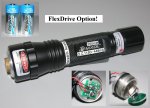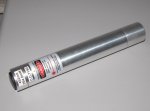jayrob
0
- Joined
- Sep 21, 2007
- Messages
- 9,862
- Points
- 113
IgorT said:Jayrob: How long does the power remain stable (as in, doesn't drop from the original number by 1mW) with a red at 250mA, and one of your massive heatsinks?
If it can keep the "exact" same power for over a minute, and we follow the suggested protocol with short measurements, the increased resolution could be beneficial.
Well, I don't have such a build to test. However, I do have some high range FlexDrives, and could set up a build like this. What I do have, is my personal FlexDrive build that has an open can diode at 448mA's. (I'm sure 250mA's would be much less heat than 448mA's)
I have it labeled at 260mW's.
I just tested it for 2 minutes with my LPM-1 optical meter.
Correction! I should have known better! In the above test, I thought that I could just hold it steady enough with my hand, but I found on the second test (laser and meter resting on the desk), that it was stable at 258.1mW's through out the test.
With the LPM-1 optical meter, just the slightest movement changes the reading... I know, I should have known better, but when I'm holding the laser by hand, I can angle it a little to get the highest reading... ;D
Jay





